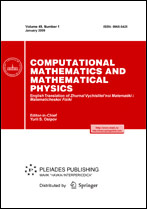|
This article is cited in 3 scientific papers (total in 3 papers)
Simulation of electrochemical machining using the boundary element method with no saturation
A. G. Petrovab, Sh. V. Sanduleanuab
a Moscow Institute of Physics and Technology, Dolgoprudnyi, Moscow oblast, Russia
b Institute for Problems in Mechanics, Russian Academy of Sciences, Moscow, Russia
Abstract:
The simulation of electrochemical machining (ECM) is based on determining the surface shape at each point in time. The change in the shape of the surface depends on the rate of the electrochemical dissolution of the metal (conducting material), which is assumed to be proportional to the electric field strength on the boundary of the workpiece. The potential of the electric field is a harmonic function outside the two domains–the tool electrode and the workpiece. Constant potentials are specified on the boundaries of the tool electrode and the workpiece. A scheme with no saturation in which the strength of the electric field created by the potential difference on the boundary of the workpiece is proposed. The scheme converges exponentially in the number of grid elements on the workpiece boundary. Given the rate of electrochemical dissolution, the workpiece boundary, which depends on time, is found. The numerical solutions are compared with exact solutions, examples of the ECM simulation are discussed, and the results are compared with those obtained by other numerical methods and the ones obtained using ECM machines.
Key words:
electrochemical machining, Dirichlet boundary value problem, boundary element method.
Received: 06.07.2015
Revised: 11.04.2016
Citation:
A. G. Petrov, Sh. V. Sanduleanu, “Simulation of electrochemical machining using the boundary element method with no saturation”, Zh. Vychisl. Mat. Mat. Fiz., 56:10 (2016), 1810–1820; Comput. Math. Math. Phys., 56:10 (2016), 1793–1802
Linking options:
https://www.mathnet.ru/eng/zvmmf10468 https://www.mathnet.ru/eng/zvmmf/v56/i10/p1810
|


| Statistics & downloads: |
| Abstract page: | 174 | | Full-text PDF : | 37 | | References: | 42 | | First page: | 9 |
|





 Contact us:
Contact us: Terms of Use
Terms of Use
 Registration to the website
Registration to the website Logotypes
Logotypes








 Citation in format
Citation in format 
